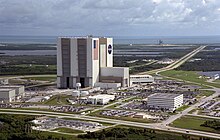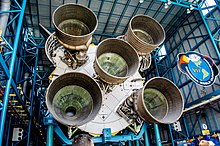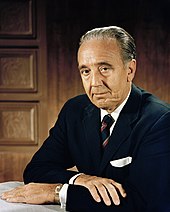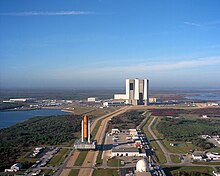Kennedy Space Center





The John F. Kennedy Space Center ( KSC , English for John F. Kennedy -Weltraumzentrum ) is the space center of NASA on Merritt Iceland in Florida . The KSC is located northwest of the USAF's Cape Canaveral Air Force Station and is adjacent to it. All manned space flights in the United States have started from here since December 1968 - first the Apollo missions and from 1981 to 2011 the space shuttles , some of which landed there again, and for the first time on May 30, 2020, a reusable Crew Dragon des from Ramp 39A private US space company SpaceX .
location
The 55 km long and 10 km wide area covers an area of around 567 km². It is the geographic coordinates 28 ° 35 '7 " N , 80 ° 39' 3" W .
17,000 people work at KSC. It is therefore a significant economic factor for the region. With a large visitor center and guided tours across the site, the KSC is also a major attraction for tourists.
Since many areas of the site are closed to the public, not least for safety reasons, the area also serves as a place for many protected wild animals. The northern tip of the island is designated as a nature reserve ( Merritt Island National Wildlife Refuge ).
The area of the US Air Force's Cape Canaveral Air Force Station (CCAFS) is located directly on a peninsula to the southeast . There satellites for military but also commercial purposes are launched. The US manned space missions as part of the Mercury , Gemini and Apollo programs started from there until October 1968 .
construction
The KSC consists of four areas: the KSC Industrial Area , the Launch Complex 39 with its two launch ramps LC-39A and LC-39B and the Shuttle Landing Facility . There is also a visitor center for tourists.
The KSC Industrial Area houses NASA administration buildings and suppliers. This is also where the Space Station Processing Facility for the International Space Station is located , as well as the Operations & Checkout Building , on the upper floor of which the astronauts live when they are in Florida for tests or before take-off.
Launch complex 39
Launch Complex 39, shown on the right in the picture, was built for the Apollo flights to the moon. In the foreground, at the lower edge of the picture, are the workshop buildings and the control center, a little to the left the Orbiter Processing Facility (OPF), in which landed space shuttles were serviced. The centerpiece of everything is the Vehicle Assembly Building (VAB), which offered assembly areas (“high bays”) for three Saturn V rockets and was later used to assemble the space shuttle with the external tank and the solid rocket. On the south side of the main building there is a lower workshop building ("Low Bay"), for the main engines of the shuttle , among other things . The VAB is 160 m high and covers an area of 218 m × 158 m.
From the VAB, two gravel tracks for the large crawler transporters lead about six km northeast in the direction of launch sites A (south) and B (north) on the Atlantic coast. The KSC has two crawler transporters with which the empty and ready-to-go shuttles were driven to the launch sites. The Saturn V rockets of the Apollo program have already been transported with these vehicles. At the time, it was a technical masterpiece not only to drive the 110 m high rockets to the launch sites in an upright position, but also to move the 5% gradient up to the launch ramps without an accident.
Launch pads LC-39A and LC-39B
The two launch ramps LC-39A and LC-39B are located a few meters behind the Atlantic beach, approx. 2.7 kilometers apart. Since the space transportation system (shuttle) was nowhere near the height of the Saturn V rockets, the original scaffolding tower was shortened and formed the 81.3 m high fixed service structure (without the lightning rod), in which all supply lines to the space shuttle ran. The rotating service structure could be turned around the space shuttle like a protective hood and, in addition to providing weather protection, was used to load the orbiter's cargo bay.
In order to protect the systems as well as the starting vehicle from the destructive sound waves, more than a million liters of water are sprayed onto the lower area within a few seconds. Even so, the Saturn V's take-offs in the town of Titusville, some 20 km away, regularly shattered windows.
In the northeast and northwest corners are the round fuel tanks for hydrogen and oxygen , each containing around 3.3 million liters of cooled liquefied gas. Due to the risk of explosion, the outer tank of the space shuttle was only filled from these two round tanks shortly before take-off.
LC-39B was no longer available for this in the final phase of the shuttle program because it was initially converted for take-offs with the Ares-I rocket. The remaining shuttle flights were only carried out by LC-39A. SpaceX now uses the LC-39A to launch the Falcon 9 and Falcon Heavy . LC-39B is being converted for the launch of the Space Launch System .
Launch complex 48
NASA built the LC-48 between the LC-39A and the SLC-41 in the southeast of Cape Canaveral Air Force Station . It was completed at the end of 2020 and is intended for the launch of small launch vehicles .
The place is laid out minimalist; it only consists of a 16 × 13 meter concrete area for the starts, two smaller ancillary areas to the southwest and northeast of it for parking equipment, access roads and a wastewater basin. Future users must bring their own starting equipment, fuel and water tanks, etc. The construction of a second, identical system on the LC-48 for the parallel use of two starting positions is possible and already planned.
Shuttle Landing Facility
3.2 km northwest of the VAB is the Shuttle Landing Facility (SLF), a 4.6 km long runway for the US space shuttles. When the orbiter landed elsewhere, it was piggybacked on a shuttle carrier aircraft to the KSC and separated from the transport aircraft directly at the runway with a special lifting device and driven to an orbiter processing facility (OPF) to be prepared for the next flight to become.
Visitor center
The so-called KSC Visitor Complex in front of the gates of the KSC serves as an information center for tourists. The commercial entertainment in the form of an IMAX 3D cinema should not hide the fact that the visitor center has a wealth of interesting information on the history of space travel in the USA. In the so-called Rocket Garden, rockets of all generations, starting with the successor to the German V2 and (in the adjacent museum) the used landing capsule from a spaceship from the 1960s, are on display.
The Visitor Complex offers guided tours through its exhibitions and is the starting point for various bus tours across the KSC site, which also include the "Apollo / Saturn V Center". There is one of the two remaining Saturn V rockets. A Saturn V mission from take-off to landing on the moon is simulated in a small theater. Bus tours to the Vehicle Assembly Building and the LC-39A launch pad are also offered.
Since May 2007, visitors to the “Shuttle Launch Experience” have been able to experience the forces that arise when a space shuttle is launched. In addition, the “ Atlantis ” space shuttle has been exhibited as a museum piece in the visitor center since the end of June 2013 .
Head of the Kennedy Space Center

Since KSC was founded, a total of ten NASA employees have served as directors, including three former astronauts (Crippen, Bridges and Cabana):
| Surname | Of | To | reference |
|---|---|---|---|
| Kurt H. Debus | July 1962 | November 1974 | |
| Lee R. Scherer | 19th January 1975 | 2nd September 1979 | |
| Richard G. Smith | September 26, 1979 | 2nd August 1986 | |
| Forrest S. McCartney | August 31, 1987 | December 31, 1991 | |
| Robert Crippen | January 1992 | January 1995 | |
| Jay F. Honeycutt | January 1995 | March 2, 1997 | |
| Roy D. Bridges | March 2, 1997 | August 9, 2003 | |
| James W. Kennedy | August 9, 2003 | January 2007 | |
| William W. Parsons | January 2007 | Mid-October 2008 (acting successor: Gene Goldman ) | |
| Robert D. Cabana | October 26, 2008 | officiating |
Web links
- KSC website (English)
- Detailed tour of facilities at KSC (English)
- Online Book: The Kennedy Space Center Story (English)
Individual evidence
- ↑ a b Kennedy’s Newest Launch Complex Ready to Serve Smaller Class of Rockets . NASA, December 11, 2020.
- ^ Emre Kelly: Meet Launch Complex 48, NASA's new small rocket pad at Kennedy Space Center. In: Florida Today. June 14, 2019, accessed June 17, 2019 .
- ^ New Homes for Space Shuttle Orbiters After Retirement. NASA, April 12, 2011, accessed April 13, 2011 .
- ↑ NASA - Biography of Dr. Kurt H. Debus . Nasa.gov. Retrieved May 5, 2012.
- ^ NASA - Biography of Lee R. Scherer . Nasa.gov. Retrieved May 5, 2012.
- ^ NASA - Biography of Richard G. Smith . Nasa.gov. Retrieved May 5, 2012.
- ^ NASA - Biography of Forrest S. McCartney . Nasa.gov. Retrieved May 5, 2012.
- ^ NASA - Biography of Robert L. Crippen . Nasa.gov. Retrieved May 5, 2012.
- ^ NASA - Biography of Jay F. Honeycutt . Nasa.gov. Retrieved May 5, 2012.
- ^ NASA - Biography of Roy Bridges . Nasa.gov. Retrieved May 5, 2012.
- ↑ NASA - NASA KSC Director Announces Retirement . Nasa.gov (February 24, 2008). Retrieved May 5, 2012.
- ^ NASA - Biography of William W. (Bill) Parsons . Nasa.gov (February 24, 2008). Retrieved May 5, 2012.
- ^ NASA: Cabana to Succeed Parsons as Kennedy Space Center Director. September 30, 2008, accessed April 18, 2016 .
- ↑ NASA: Cabana Assumes Role As Tenth NASA Kennedy Space Center Director. October 30, 2008, accessed April 18, 2016 .




